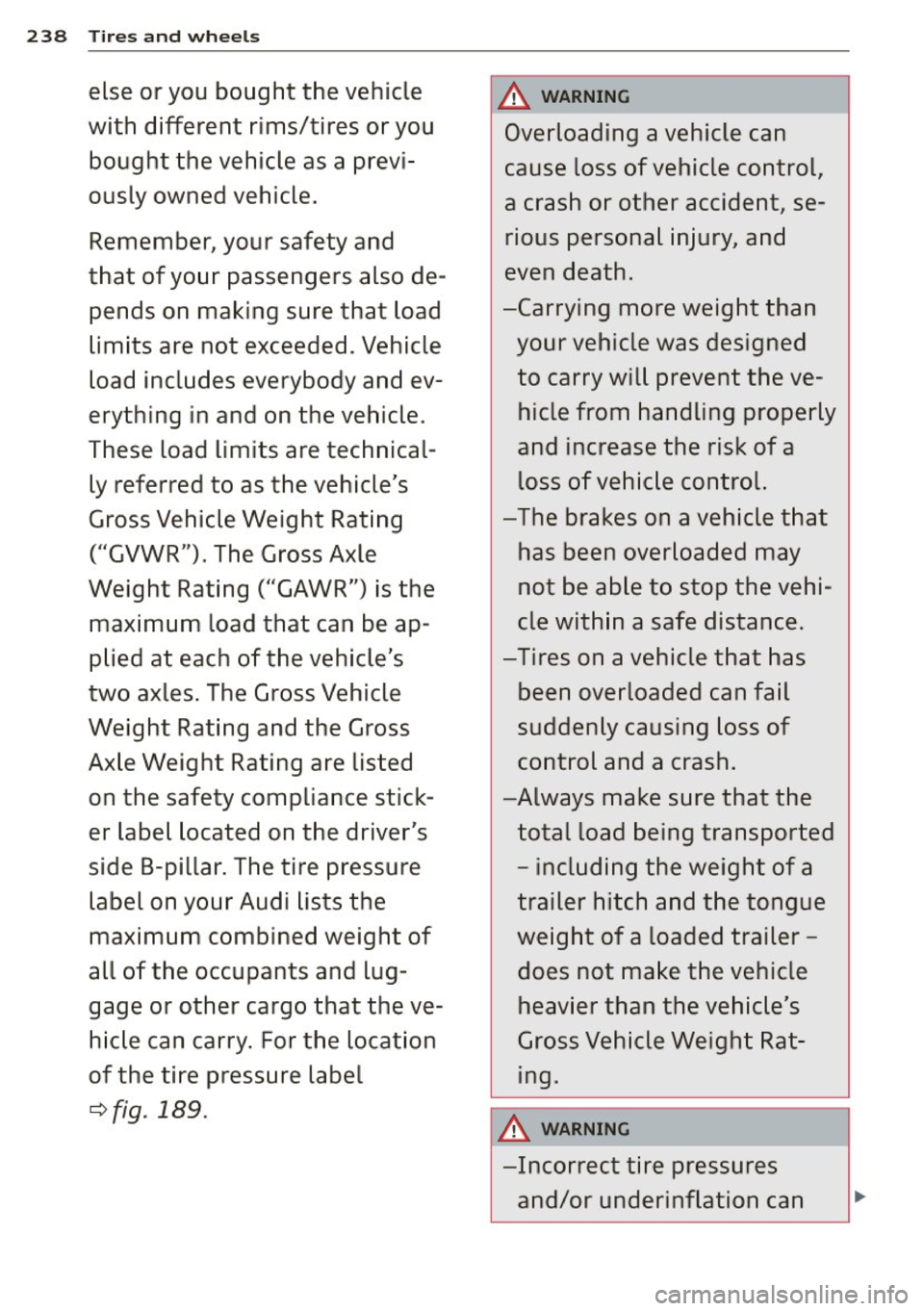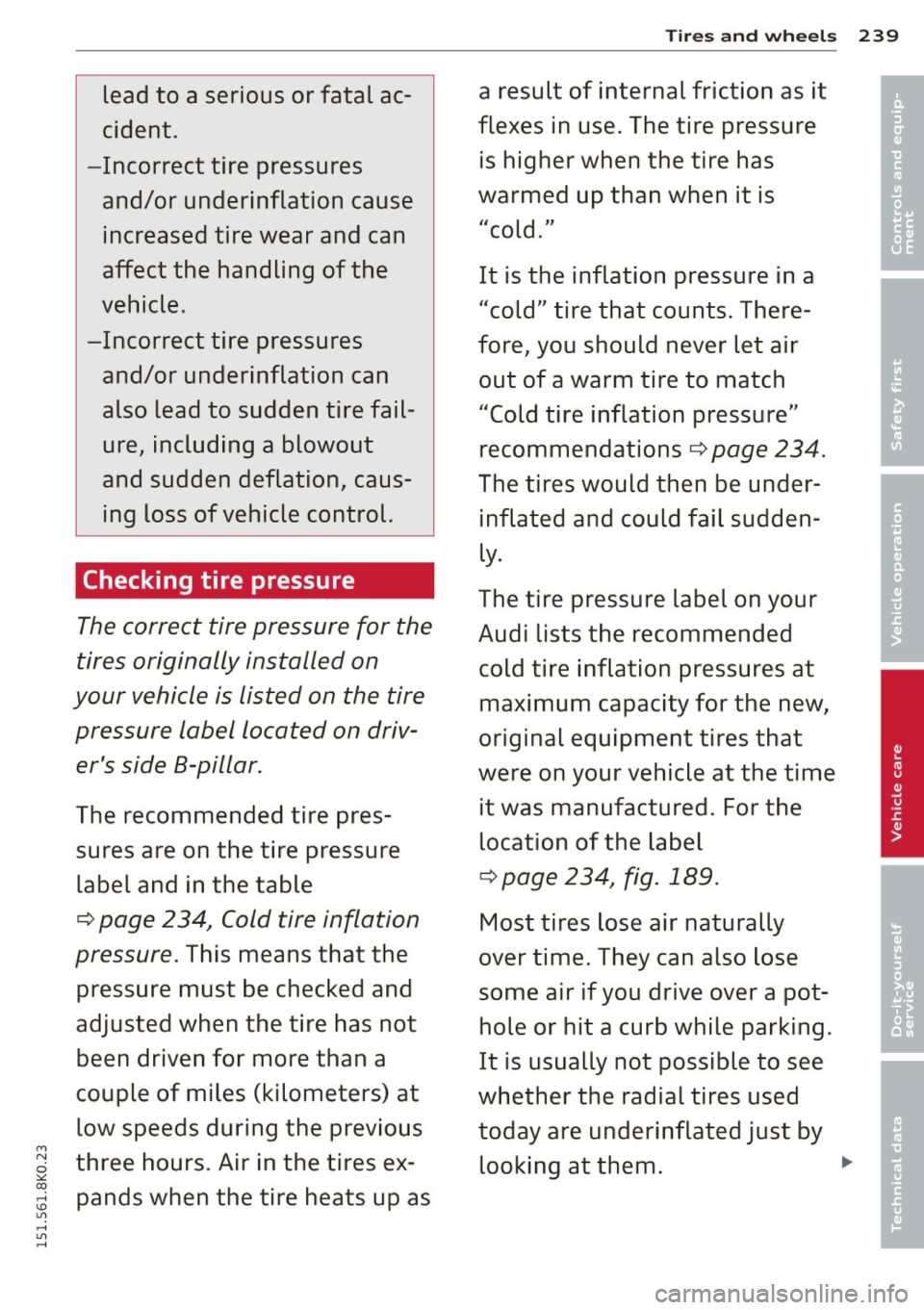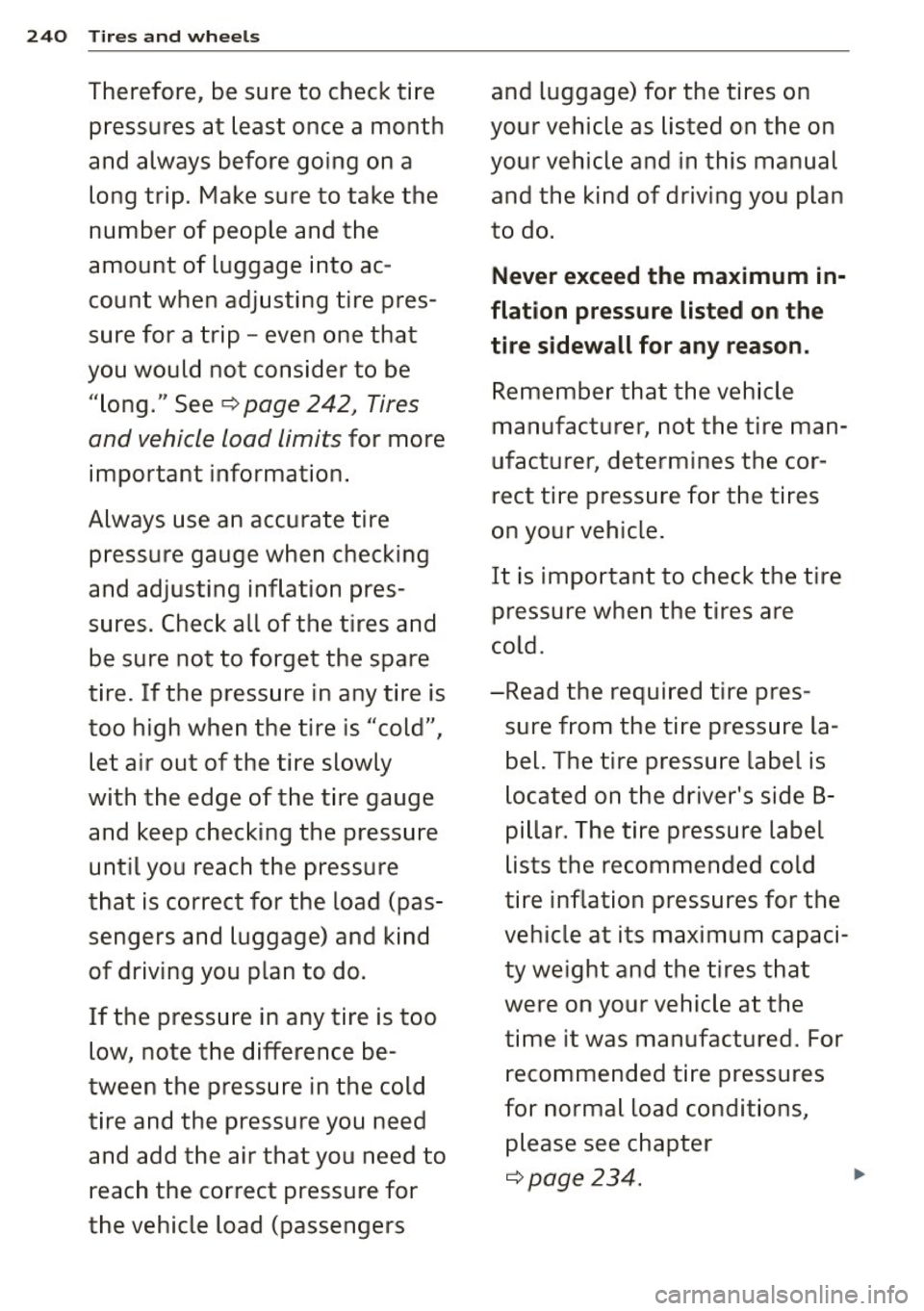2015 AUDI A4 wheel
[x] Cancel search: wheelPage 233 of 304

Maximum load rating
means the load rating for a tire
at the maximum permissible in
flation pressure for that tire.
Maximum loaded vehicle
weight
means the sum of:
(a) Curb weight
(b) Accessory weight
(c) Vehicle capacity weight, and
(d) Production options weight
Maximum (permissible)
inflation pressure
means the maximum cold infla
tion pressure to which a tire
may be inflated. Also called
"maximum inflation pressure."
Normal occupant weight
means 150 lbs. (68 kilograms)
times the number of occupants seated in the vehicle up to the
total seating capacity of your
vehicle.
Occupant distribution
means distribution of occu pants in a vehicle.
Outer diameter
means the overall diameter of
an inflated new tire.
Tires and wheels 231
Overall width
means the linear distance be
tween the exteriors of the side
walls of an inflated tire, includ ing elevations due to labeling,
decorations, or protective bands or ribs.
Ply
means a layer of rubber-coated
parallel cords.
Production options weight
means the combined weight of
those installed regular produc
tion options weighing over 5 lbs. (2 . 3 kg) in excess of those
standard items which they re place, not previously consid
ered in curb weight or accessory
weight, including heavy duty
brakes, ride levelers, roof rack,
heavy duty battery , and special
trim.
Radial ply tire
means a pneumatic tire in
which the ply cords that extend
to the beads are laid at sub stantially 90 degrees to the
centerline of the tread.
•
•
'
Page 234 of 304

232 Tires a nd whee ls
Recommended inflation
pressure
see c:::> page 230, Cold tire infla
tion pressure.
Reinforced tire
means a tire design to operate
at higher loads and at higher
inflation pressures than the
corresponding standard t ire .
Reinforced tires may be identi
fied as "XL", "xl", "EXTRA
LOAD", or "RF" on the sidewa ll.
Rim
means a meta l support for a
tire or a tire and tube assembly
upon which the tire beads are
seated .
Rim diameter
means nominal diameter of the
bead seat. If yo u change your
wheel size, you will have to pur
chase new t ires to ma tch the
new rim d iameter .
Rim size designation
means rim diameter and width.
Rim width
means nom inal distance be
tween rim flanges.
Sidewall
means that por tion of a tire be
tween the tread and bead.
Speed rating (letter code)
means the speed at wh ich a tire
is designed to be driven for ex
tended periods of time . The rat
ings range from 93 mph
( 1 50 km/h) to 186 mph
( 2 98 km/h)
c:::> page 2 50. You
may not find th is informat ion
on all tires because it is not re
quired by law.
The speed rati ng letter code,
where applicable, is molded on
the ti re sidewall and ind icates
the maximum permissible road
speeds
c:::> & in Winter tires on
page 255.
Tire pressure monitoring
system*
means a system that detects
when one or more of a vehicle's
tires are underinflate d an d ill u
minates a low tire press ure
warn ing telltale.
Tread
means that por tion o f a tire
that comes into contact with
the road.
Page 235 of 304

Tires and wheels 233
Tread separation UTQG information on the tires, •
means pulling away of the molded into the sidewalls. • '
tread from the tire carcass. U.S. DOT Tire Identification
Treadwear indicators (TWI) Number (TIN)
means the projections within
This is the tire
's "serial num-
the principal grooves designed ber". It begins with the letters
to give a visual indication of the "DOT" and indicates that the
degrees of wear of the tread. tire meets all federal stand-
See
¢ page 245, Tread Wear ards. The next two numbers or
Indicator (TWI) for more infor- letters indicate the plant where
mation on measuring tire wear. it was manufactured, and the
Uniform Tire Quality Grading
last four numbers represent the
week and year of manufacture.
is a tire information system de- For example,
veloped by the United States
DOT ... 2214 ...
National Highway Traffic Safety
Administration (NHTSA) that is means that the tire was pro-
designed to help buyers make duced in the 22nd week of
relative comparisons among 2014. The other numbers are
tires. The UTQG is not a safety marketing codes that may or
rating and not a guarantee that may not be used by the tire
a tire will last for a prescribed manufacturer. This information
number of miles (kilometers) or is used to contact consumers if
perform in a certain way. It a tire defect requires a recall.
simply gives tire buyers addi-
Vehicle capacity weight
tional information to combine means the rated cargo and lug-
with other considerations, such gage load plus 1
SO lbs.
as price, brand loyalty and deal- (68 kilograms) times the vehi-
er recommendations. Under cle's total seating capacity as
UTQG, tires are graded by the listed on the label located on
'"" tire manufacturers in three N
0 the driver's side 8-pillar. ...
::.,:
areas: treadwear, traction, and co ,...., \!) 1.1'1 temperature resistance. The ,...., 1.1'1 ,....,
Page 237 of 304

Tires and wheels 235
Tire pressure generally refers to tant things you can do to help •
the amount of air in a tire that avoid sudden tire failure. Un-• '
it needs it to do its job and derinflated tires are a major
safely carry the combined load cause of sudden tire failure. of the entire vehicle and its con- Keeping tires at the right pres-
tents. Tire pressure is measured sure is also important for safe
in kilopascals (kPa), the inter- and responsive vehicle han-
national measuring unit and in dling, traction, braking and
pounds per square inch (PSI) . load carrying.
Tire pressures
Tire pressure is based in part on are particularly important
the vehicle's design and load when the vehicle is being driv-
limit - the greatest amount of en at higher speeds, and then
weight that the vehicle can car -especially when heavily loaded
ry safely and the tire size. The even within the permissible
proper tire pressure is frequent-load-carrying capacities ap-
ly referred to as the "recom-proved for your vehicle.
mended cold tire inflation pres-The recommended tire pres-
sure ." Air in the tires expands
sures for your Audi depend on
when the tire heats up because the kind of tires on your vehicle
of internal friction when it flex- and the number of passengers
es in use. The tire pressure is and/or amount of luggage you
higher when the tire has will be transporting.
warmed up than when it is The tire pressure label is locat-
"cold. " It is the inflation pres-
ed on the driver's side B-pillar.
sure in a "cold" tire that counts.
Therefore, you should never let The tire pressure label lists the
recommended cold tire infla-
air out of a warm tire to match
"cold tire inflation pressure" tion pressures for the vehicle at
its maximum capacity weight
recommendations. The tires
would then be underinflated and tires that were on your ve
-
and could fail suddenly. hicle at the time it was manu-
'"" factured
. N
0
Maintaining proper tire pres-::.,: co ,...., \!)
sure is one of the most impor-1.1'1 ,...., 1.1'1 ,....,
Page 239 of 304

'"" N
0 ::.,: co ,...., \!) 1.1'1 ,...., 1.1'1 ,....,
Tires and wheels 237
Model Tire designation Tire pressure
• Engine
normal load condition full load condition
• (up to 3 occupants)
front rear front rear
PSI kPA PSI kPA PSI kPA
PSI kPA
A4 Sedan: 225/55 Rl6 95H
32 220 29 200 33 230 35 240 2.0 liter All Season
4-cylinder 245/45 Rl 7 95H
All Season
32 220 29 200 33 230 35 240
245/40 Rl8 93V 32 220 29 200 33 230
35 240 High Performance
225/50 Rl 7 94H
33 230 30 210 35 240
36 250 All Season
245/40 Rl8 93H
33 230 32 220 36 250 38 260 All Season
255/35 Rl9 96V XL
32 220
30 210
35 240
35 240
High Performance
allroad: 225/55 Rl 7 97H
30 210 30 210 33 230 36 250 2.0 liter All Season
4-cylinder 245/45 Rl8 lOOH
All Season
32 220 32 220 33 230 36 250
24S/4S R18 96Y
30 210 30 210 33 230 36 250 High Performance
245/40 R19 98Y XL
32 220 29 200 35 240 38 260 High Performance
S4 Sedan: 245/40 Rl8 93H
36 250 32 220 41 280 41 280 3.0 liter
All Season
6-cylinder 245/40 Rl8 93Y
High Performance
39 270
35 240 41
280 41
280
255/35 Rl9 96YXL
39 270 33 230 41 280 41 280 High Performance
XL= reinforced or extra load tire. It may also appear as xl, EXTRA LOAD, or RF on the tire side-
wall.
The correct tire pressure for the
spare wheel is located on a la
bel on the driver's side B-pillar.
Because technical changes may
be made to vehicle equipment
during the model year, always
compare the tire size designa- tion on the tire pressure label
on your vehicle with the tires on
your vehicle. Make sure that the
tire size information on the ve hicle label is the same as the
size of the tires on the vehicle.
This is especially important if
the vehicle belongs to someone ""
Page 240 of 304

238 Tires and wheels
else or you bought the vehicle
with different rims/tires or you bought the vehicle as a previ
ously owned vehicle.
Remember, your safety and
that of your passengers also de
pends on making sure that load
limits are not exceeded. Vehicle
load includes everybody and ev
erything in and on the vehicle.
These load limits are technical
ly referred to as the vehicle's
Gross Vehicle Weight Rating ("GVWR"). The Gross Axle
Weight Rating ("GAWR") is the maximum load that can be ap
plied at each of the vehicle's
two axles . The Gross Vehicle
Weight Rating and the Gross
Axle Weight Rating are listed
on the safety compliance stick
er label located on the driver's
side B-pillar. The tire pressure
label on your Audi lists the
maximum combined weight of
all of the occupants and lug
gage or other cargo that the ve
h icle can carry . For the location
of the tire pressure label
¢fig . 189.
.&_ WARNI NG -
Overloading a vehicle can
cause loss of vehicle control,
a crash or other accident, se
rious personal injury, and
even death.
-Carrying more weight than
your vehicle was designed to carry will prevent the ve
hicle from handling properly
and increase the risk of a
loss of vehicle control.
-The brakes on a vehicle that
has been overloaded may not be able to stop the vehi
cle with in a safe distance .
-Tires on a vehicle that has been overloaded can fail
suddenly causing loss of
control and a crash.
- Always make sure that the
total load being transported
- including the weight of a
trailer hitch and the tongue
weight of a loaded trailer - does not make the vehicle
heavier than the vehicle's
Gross Vehicle Weight Rating.
.&_ WARNI NG
-Incorrect tire pressures
and/or underinflation can
-
Page 241 of 304

lead to a serious or fatal ac
cident.
- Incorrect tire pressures
and/or underinflation cause increased tire wear and can
affect the handling of the
vehicle .
-Incorrect tire pressures and/or underinflation can
also lead to sudden tire failure, including a blowout
and sudden deflation, caus ing loss of vehicle control.
Checking tire pressure
The correct tire pressure for the
tires originally installed on
your vehicle is listed on the tire pressure label located on driver 's side 8-pillar.
The recommended tire pres
sures are on the tire pressure
label and in the table
c:> page 234, Cold tire inflation
pressure.
This means that the
pressure must be checked and
adjusted when the tire has not
been driven for more than a
couple of miles (kilometers) at
low speeds during the previous
three hours. Air in the tires ex pands when the tire heats up as
Tires and wheels 239
a result of internal friction as it
flexes in use. The tire pressure is higher when the tire has
warmed up than when it is " ld ,, co .
It is the inflation pressure in a
"cold" tire that counts. There
fore, you should never let air
out of a warm tire to match
"Cold tire inflation pressure" recommendations
c:> page 234.
The tires would then be under inflated and could fail sudden
ly.
The tire pressure label on your
Audi lists the recommended cold tire inflation pressures at maximum capacity for the new,
original equipment tires that
were on your vehicle at the time it was manufactured. For the
location of the label
c:> page 234, fig. 189.
Most tires lose air naturally
over time. They can also lose
some air if you drive over a pot hole or hit a curb while parking.
It is usually not possible to see
whether the radial tires used
today are underinflated just by looking at them.
•
•
'
Page 242 of 304

240 Tires and wheels
Therefore, be sure to check tire and luggage) for the tires on
pressures at least once a month your vehicle as listed on the on
and always before going on a your vehicle and in this manual
long trip. Make sure to take the and the kind of driving you plan
number of people and the to do.
amount of luggage into ac-
Never exceed the maximum in-
count when adjusting tire pres-flation pressure listed on the
sure for a trip -even one that tire sidewall for any reason.
you would not consider to be
Remember that the vehicle
" long ." See
¢ page 242, Tires
manufacturer, not the tire man-and vehicle load limits for more
important information. ufacturer, determines the cor-
rect tire pressure for the tires
Always use an accurate tire on your vehicle.
pressure gauge when checking It is important to check the tire
and adjusting inflation pres-
pressure when the tires are
sures. Check all of the tires and
be sure not to forget the spare cold
.
tire. If the pressure in any tire is -Read the
required tire pres-
too high when the tire is "cold", sure from the tire pressure
la-
let air out of the tire slowly bel.
The tire pressure label is
with the edge of the tire gauge located
on the driver's side B-
and keep checking the pressure pillar. The tire pressure label
until you reach the pressure lists the recommended cold
that is correct for the load (pas- tire inflation
pressures for the
sengers and luggage) and kind vehicle at its maximum capaci-
of driving you plan to do. ty weight and the tires that
If the pressure in any tire is too were on your
vehicle at the
time it was manufactured. For
low, note the difference be-
tween the pressure in the cold recommended
tire pressures
for normal load conditions,
tire and the pressure you need
please see chapter
and add the air that you need to
¢page 234. ...
reach the correct pressure for
the vehicle load (passengers